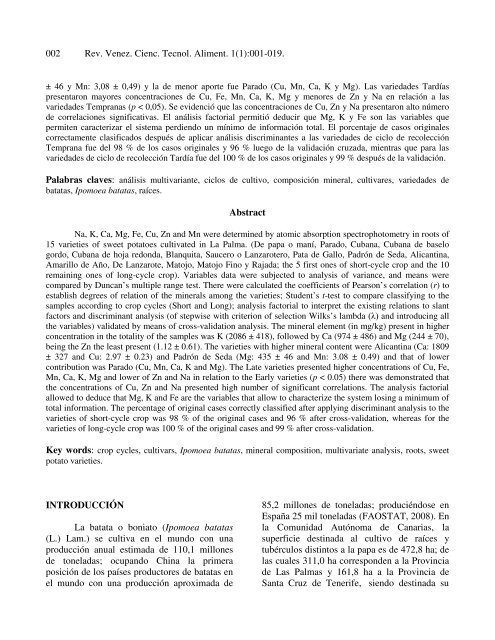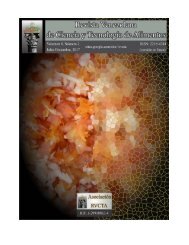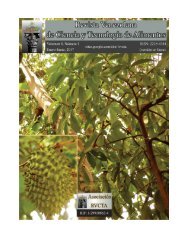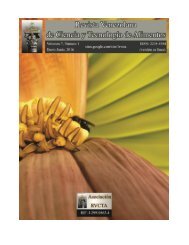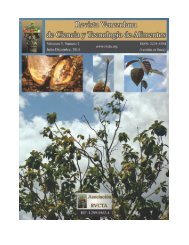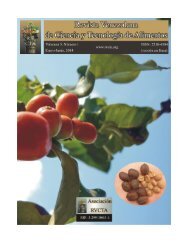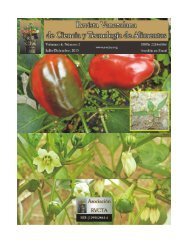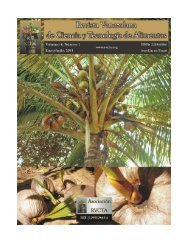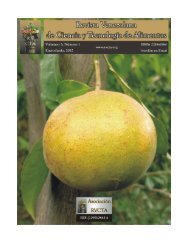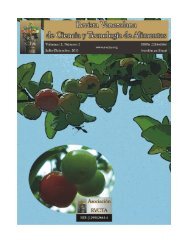RVCTA Volumen 1 - Número 1
You also want an ePaper? Increase the reach of your titles
YUMPU automatically turns print PDFs into web optimized ePapers that Google loves.
002 Rev. Venez. Cienc. Tecnol. Aliment. 1(1):001-019.<br />
± 46 y Mn: 3,08 ± 0,49) y la de menor aporte fue Parado (Cu, Mn, Ca, K y Mg). Las variedades Tardías<br />
presentaron mayores concentraciones de Cu, Fe, Mn, Ca, K, Mg y menores de Zn y Na en relación a las<br />
variedades Tempranas (p < 0,05). Se evidenció que las concentraciones de Cu, Zn y Na presentaron alto número<br />
de correlaciones significativas. El análisis factorial permitió deducir que Mg, K y Fe son las variables que<br />
permiten caracterizar el sistema perdiendo un mínimo de información total. El porcentaje de casos originales<br />
correctamente clasificados después de aplicar análisis discriminantes a las variedades de ciclo de recolección<br />
Temprana fue del 98 % de los casos originales y 96 % luego de la validación cruzada, mientras que para las<br />
variedades de ciclo de recolección Tardía fue del 100 % de los casos originales y 99 % después de la validación.<br />
Palabras claves: análisis multivariante, ciclos de cultivo, composición mineral, cultivares, variedades de<br />
batatas, Ipomoea batatas, raíces.<br />
Abstract<br />
Na, K, Ca, Mg, Fe, Cu, Zn and Mn were determined by atomic absorption spectrophotometry in roots of<br />
15 varieties of sweet potatoes cultivated in La Palma. (De papa o maní, Parado, Cubana, Cubana de baselo<br />
gordo, Cubana de hoja redonda, Blanquita, Saucero o Lanzarotero, Pata de Gallo, Padrón de Seda, Alicantina,<br />
Amarillo de Año, De Lanzarote, Matojo, Matojo Fino y Rajada; the 5 first ones of short-cycle crop and the 10<br />
remaining ones of long-cycle crop). Variables data were subjected to analysis of variance, and means were<br />
compared by Duncan’s multiple range test. There were calculated the coefficients of Pearson’s correlation (r) to<br />
establish degrees of relation of the minerals among the varieties; Student’s t-test to compare classifying to the<br />
samples according to crop cycles (Short and Long); analysis factorial to interpret the existing relations to slant<br />
factors and discriminant analysis (of stepwise with criterion of selection Wilks’s lambda (λ) and introducing all<br />
the variables) validated by means of cross-validation analysis. The mineral element (in mg/kg) present in higher<br />
concentration in the totality of the samples was K (2086 ± 418), followed by Ca (974 ± 486) and Mg (244 ± 70),<br />
being the Zn the least present (1.12 ± 0.61). The varieties with higher mineral content were Alicantina (Ca: 1809<br />
± 327 and Cu: 2.97 ± 0.23) and Padrón de Seda (Mg: 435 ± 46 and Mn: 3.08 ± 0.49) and that of lower<br />
contribution was Parado (Cu, Mn, Ca, K and Mg). The Late varieties presented higher concentrations of Cu, Fe,<br />
Mn, Ca, K, Mg and lower of Zn and Na in relation to the Early varieties (p < 0.05) there was demonstrated that<br />
the concentrations of Cu, Zn and Na presented high number of significant correlations. The analysis factorial<br />
allowed to deduce that Mg, K and Fe are the variables that allow to characterize the system losing a minimum of<br />
total information. The percentage of original cases correctly classified after applying discriminant analysis to the<br />
varieties of short-cycle crop was 98 % of the original cases and 96 % after cross-validation, whereas for the<br />
varieties of long-cycle crop was 100 % of the original cases and 99 % after cross-validation.<br />
Key words: crop cycles, cultivars, Ipomoea batatas, mineral composition, multivariate analysis, roots, sweet<br />
potato varieties.<br />
INTRODUCCIÓN<br />
La batata o boniato (Ipomoea batatas<br />
(L.) Lam.) se cultiva en el mundo con una<br />
producción anual estimada de 110,1 millones<br />
de toneladas; ocupando China la primera<br />
posición de los países productores de batatas en<br />
el mundo con una producción aproximada de<br />
85,2 millones de toneladas; produciéndose en<br />
España 25 mil toneladas (FAOSTAT, 2008). En<br />
la Comunidad Autónoma de Canarias, la<br />
superficie destinada al cultivo de raíces y<br />
tubérculos distintos a la papa es de 472,8 ha; de<br />
las cuales 311,0 ha corresponden a la Provincia<br />
de Las Palmas y 161,8 ha a la Provincia de<br />
Santa Cruz de Tenerife, siendo destinada su


